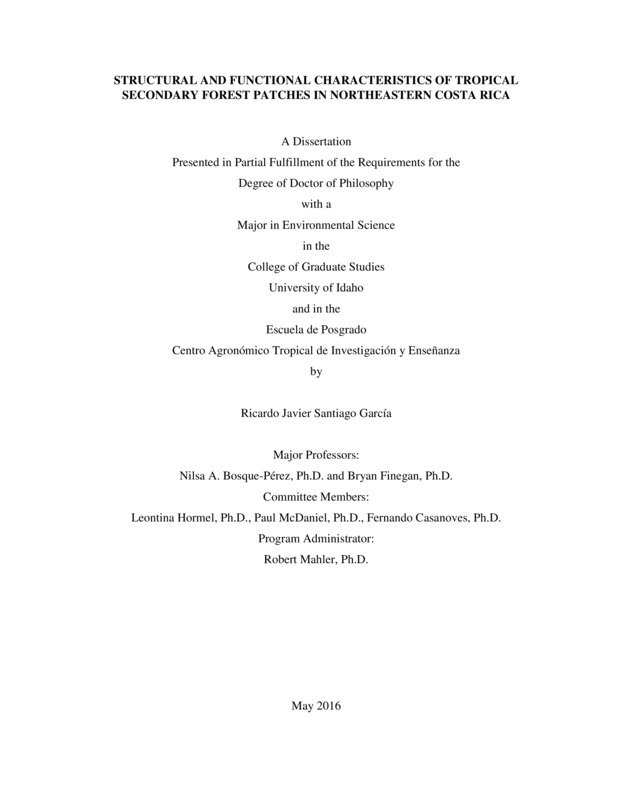Structural and functional characteristics of tropical secondary forest patches in northeastern Costa Rica
Santiago, Ricardo Javier. (2016). Structural and functional characteristics of tropical secondary forest patches in northeastern Costa Rica. Theses and Dissertations Collection, University of Idaho Library Digital Collections. https://www.lib.uidaho.edu/digital/etd/items/santiago_idaho_0089e_10926.html
- Title:
- Structural and functional characteristics of tropical secondary forest patches in northeastern Costa Rica
- Author:
- Santiago, Ricardo Javier
- Date:
- 2016
- Embargo Remove Date:
- 2018-06-02
- Program:
- Environmental Science
- Subject Category:
- Ecology
- Abstract:
-
Tropical forests are being threatened by land-use change and deforestation and has created human-modified landscapes of secondary and old-growth forests within a diverse matrix of agricultural uses. We developed an interdisciplinary team project to investigate social-ecological interactions of agricultural intensification in the San Juan-La Selva (SJLS) Biological Corridor in northeastern Costa Rica. This landscape has undergone massive deforestation for conversion to pastures for cattle ranching, and the expansion and intensification of non-traditional exports. Tropical secondary forests are patches of vegetation that regrow naturally in these former pastures. These forests regenerate within this intricate landscape, resulting in patches with complex spatial configurations; albeit the effects of variable landscape configurations on the structure and composition of secondary forests is relatively unknown. In this study, we assessed the relative effects of landscape spatial configuration, environmental variables, forest age and patch spatial location on the structure and composition of seedlings, saplings and trees. Our study was located within the SJLS Biological Corridor, where we established 25, 0.25 ha secondary forest plots located in abandoned pastures, ranging in age from 15 to 55 years post-abandonment. We found that each recruitment stage is affected differentially, with seedling composition mostly affected by soils, while seedling density and diversity were affected by landscape variables. Sapling density and diversity were mostly influenced by landscape configuration while tree species density was influenced by soils. Using six functional traits from 123 species, we analyzed the relative contribution of forest age, spatial location, landscape and environmental factors influencing the functional composition and diversity of sapling assemblages. Functional composition was mostly influenced by soils, while functional diversity was influenced by the plots’ spatial location. Leaf dry matter content and leaf nitrogen declined with forest age, while functional divergence increased with forest age. This study highlights the importance of explicitly including landscape spatial configuration as a predictor variable when assessing the structure and composition of tropical secondary forest patches and the need to assess the relative contribution of forest age, spatial location, landscape and environmental variables on each recruitment stage separately.
- Description:
- doctoral, Ph.D., Environmental Science -- University of Idaho - College of Graduate Studies, 2016
- Major Professor:
- Bosque-Pérez, Nilsa A; Finegan, Bryan
- Committee:
- Hormel, Leontina; McDaniel, Paul; Casanoves, Fernando
- Defense Date:
- 2016
- Identifier:
- Santiago_idaho_0089E_10926
- Type:
- Text
- Format Original:
- Format:
- application/pdf
- Rights:
- In Copyright - Educational Use Permitted. For more information, please contact University of Idaho Library Special Collections and Archives Department at libspec@uidaho.edu.
- Standardized Rights:
- http://rightsstatements.org/vocab/InC-EDU/1.0/

